Rebecca Eanes's Blog, page 4
January 27, 2017
A Word of Encouragement for When You're Tired

My children are now 10 and 8. The baby days are long gone. I can no longer pick them up. I'll never carry them on my hip again. I miss it. But this season is beautiful, too. They're amazing to watch as they transform into young men a little more each day.
I know many of you reading this have babies, toddlers, and preschoolers. You don't get a full night of sleep, ever. You're bone tired, but it doesn't matter because they still need you constantly.
I have to confess, I co-slept with my kids until they were 7 and 5. That's when they said they were ready for me to go. I slept in their room. Neither of my kids slept through the night until they were 3. THREE. That's a lot of interrupted sleep. I'd get the toddler back to sleep around the same time the baby woke up. Repeat. Repeat. Repeat. Even when they did finally start sleeping through most nights, they still couldn't fall asleep without me.
I chose to do it my way even though the doctor said "get him out of your bed" and others warned how I'd ruin them. I questioned my decisions constantly. Would they ever sleep all night? Would they need me to move into their dorm room one day to rub their backs and tell them a story? I didn't know. I just kept following my heart and putting my faith in love.
Now don't misunderstand. I'm not saying this is what anyone SHOULD do. No, no. You do it your way. You follow your heart. There is no one right way to do this, mamas and daddies.
I just wanted to offer this up to those of you who have chosen to co-sleep or who still have kids that wander into your bed at night or wake several times. For those of you who still lay by your child until they fall asleep. I remember the exhaustion. I remember wishing that they would just please, please go to sleep and stay asleep for once. I remember feeling it would never end.
I remember the tired, but even more so, what really sticks out in my mind as I look back on those days are the giggles, the stories, the laughter, the scent of baby shampoo, the love. The LOVE. I remember taking pretend adventures to outer space or gathering gems from the cave of a dragon. I remember sneaking my arm out from under his head and catching a glimpse of his sleeping face in the moonlight and tears welling up in my eyes because, oh my gosh, how lucky am I?
And even now, once a weekend I say, "Come in here, let's have a sleepover in my room." We watch movies and fall asleep in a tangled heap of long limbs, and I try to fit in the 4 inches of space that's left because I know if babyhood was just yesterday, then, well, tomorrow they'll be grown and gone. Then I'll have an empty space awaiting grandchildren to come and fill it.
So, snuggle them up. Don't let anyone make you feel like you're doing something wrong, or not being tough enough. Don't let them scare you into thinking you're ruining your kids or bully you into making a decision that doesn't feel right to you. You just snuggle them and hold on tight and know that this long, trying, and exhausting day will be your beautiful, sweet, and cherished memory tomorrow. That's the power of love.
Published on January 27, 2017 13:53
January 26, 2017
When You Feel Less Than, Remember This
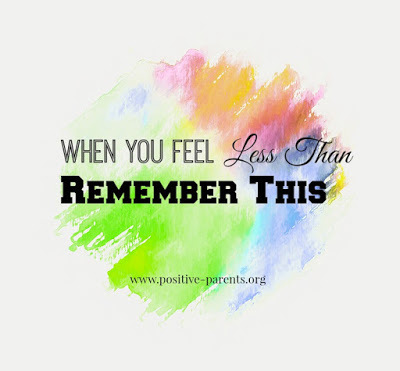
I've been feeling off-center for the last few days. There is an uneasy feeling lying heavy on my chest, and through my journaling this morning, I figured out what it was.
It's the feeling of being less than.
Less than the mom whose kid has $120 shoes and packs his ultra healthy lunch in an organized box that matches his rolling bookbag. My son took his less than stellar lunch in a paper sack this morning because he left his lunch box at school yesterday. He was wearing his designer Walmart shoes.
Less than the mom who is travelling around the world speaking to thousands while still building loving relationships at home. The thought of speaking to crowds gives me hives, and I'm still figuring out how to balance everything at home.
Less than the author who is on the New York Times list. I didn't quite make it.
Less than the mom who is at drop off at 7:45 a.m. with a full face of make-up and something other than yoga pants. I went through car line in my pajamas.
Less than the woman I see on screen with her toned arms and flat abs. My arms wave for several seconds after my hand stops waving.
Do you know what all this feeling less than does? It makes me ashamed. It makes me feel inadequate. It makes me feel like a failure as an author, a wife, a mom, a woman.
Not enough. Not enough. Not enough becomes the constant weight on my chest and all the inspirational stuff I've read so many times before about self-love and acceptance seems to get swallowed up by the monster of comparison. I don't even realize I'm doing it. I don't look at the put-together mom and think "wow, you look so much better than me this morning" or at my friends who are doing really well in their fields and think "you are just way better than I'll ever be." No, I don't compare out loud in my mind. It's something that forms just beneath there, and I don't realize it until I feel the weight.
Maybe you have that weight on your chest today. Maybe you even read my blog, books, or posts and think "she has this all figured out." I assure you, I don't. My life isn't picture perfect, and I'm sure none of the above-mentioned moms, speakers, authors, and models have picture perfect lives either. What I perceive as their perfection is really just a glimpse of what they put out there and very, very far from the whole story.
So, remember this the next time you feel the weight of not enough. You are beautiful. Your imperfections don't make you any less beautiful because beauty shines from the soul who shows up, who tries again, who loves another day. You are loved. That's why you're so worn out, mama. It's because you are so very loved. How do you know which stuffed animal your child loves the most? The one that's ragged and worn. Before I had kids, my eyes were brighter and my roots didn't show, but I'm ragged and worn a bit now. I've been loved up real good. If you're looking a little rough around the edges today, smile in the mirror and remember why.
When you realize that you've been comparing yourself to others, breathe in this truth - nothing compares to you. You are unique. No one else has your story. You are worthy and lovable no matter what mistakes you've made in the past. You have today, and it's full of possibilities. To relieve the weight on your chest, count the blessings and joys before you. Repeat as often as needed.

Published on January 26, 2017 07:53
How to Use Time-In (An Alterative to Time-Out)
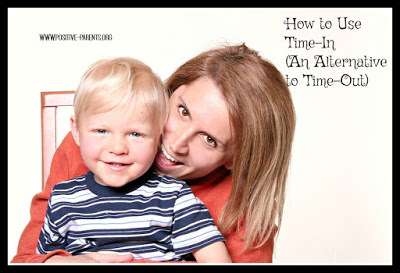
You know the scene. You’re trying to get your screaming, kicking child to sit in the time-out chair, and he’s not cooperating. He gets up every 3 seconds, so you have to keep wrangling him into the chair. Time restarts because he got up again. Three minutes end up lasting 20. He’s crying, and you’re about to cry…or scream…or give up entirely and go for a glass of wine. Time-outs can be a huge power struggle, especially if you have a strong-willed kid. They’re hard on sensitive kids , too. Most of the time, they don’t even work to change behavior and you end up stuck in an endless loop of misbehavior, time-outs, and frustration. Nothing sucks the joy out of parenting quite like everyday power struggles.
The good news is that there is an alternative that many parents, myself included, find to be much more effective. To understand how to implement time-in, you first need to understand why this approach makes sense. Read The Brain Science that Changes Parenting for a more comprehensive post on the “why” behind this time-out alternative. To summarize for the purpose of this article, the brain, to greatly simplify, can be divided into two main parts which Dr. Tina Payne-Bryson and Dr. Daniel Siegel refer to as the “upstairs brain” and “downstairs brain.” Upstairs is where higher reasoning, logical thinking, empathy, regulating emotions, morality, and more are housed. Downstairs is primitive and reactive.
“We want to engage the higher parts that can help override the lower, reactive parts. Which part of the brain do you think punishment appeals to? Which part does being ignored appeal to? What about threatening? These parental behaviors all activate the reactive reptilian brain. They (Bryson and Siegel) call this “poking the lizard.” But, by demonstrating empathy and respect and engaging in problem-solving, you don’t communicate a threat, and the reptilian brain can relax its reactivity. This is why I moved from time-out (which my son perceived as a threat) to time-in, because I wanted to appeal to his upper brain, not continue lighting up their lower brain. It’s why I now engage both my children in problem-solving when a problem arises rather than punishing them.Using this knowledge, the first phase of time-in is to actually calm the child’s brain down. We want him to have access to his higher brain, and that can’t happen until he’s unlocked from the reactive lower brain, and when he’s alarmed, he’s reactive. Social isolation or the threat of social isolation causes alarm. By approaching your child with empathy, calmness, and gentleness (using your own higher brain) you will appeal to his higher brain. Mirror neurons at work! So, you will approach the child using your mature higher brain and invite him into your lap into a safe space with you. In this space, it’s a good idea to have several different calming tools for your child, such as a calm-down jar , books, crayons and paper, etc. However, if you aren’t at home, or you haven’t get set up such as space, your loving arms is certainly good enough.
When we consistently help a child to calm down and work with them to teach good decision-making, we are actually strengthening the neural connections in their upstairs brain.”
This first phase does two things. First, it removes the child from the situation or interrupts the problem behavior. That’s the same thing a traditional time-out does, right? It communicates “stop, this isn’t acceptable.” Time-in goes a step further here because rather than leaving the child in a corner or chair, you are now going to help him grow a better brain and learn more acceptable behavior.
But wait, you say! Isn’t this a reward? Read Does Time-In Reward Children?
Once you have him calmed down (I use “him” often because I raise boys and it’s sort of the default setting in my brain) you move on to phase 2 by appealing to his higher brain. You do this by asking questions. “Do you see Sophie’s face? She looks sad because you pinched her. I wonder how we can help her feel better?” Don’t try this until he’s calm because it just won’t work. Let him offer suggestions on how to right his wrong. This is teaching him problem-solving skills and placing the responsibility of reparation on him. He’s learning that he needs to fix the problem he created. If he can’t come up with anything, then you can offer suggestions. “Do you think saying I’m sorry will help? Yes? Okay, we’ll go do that, but the next time you get upset with a friend, you can either say ‘I’m mad right now’ and walk away or you can take 3 big dinosaur breaths. Let’s practice those dinosaur breaths. Good. Let’s go apologize now.”
Time-out = Child learns a behavior is unacceptable and sits in a corner for 3 minutes.
Time-in= Child learns a behavior is unacceptable, learns self-regulation skills, takes responsibility for the behavior, and learns acceptable ways to handle a situation. Plus his connection with you isn’t broken, and he isn’t left feeling bad about himself.
But What If…
My child is having a tantrum and is hitting me or screaming? If your calm demeanor, tone, and words do not soothe your child enough to be brought into your lap or a safe space, then you can move the child to safe place and stand back. The key is to remain emotionally and physically available rather than just ignoring. “I won’t let you hit me so I’m going to stand over here to keep myself safe, but when you’re ready for a hug, I’ll be right here.” Some kids need a bit of space to work it out, and that’s perfectly okay. The difference is respecting the need for space versus forcing it.My child refuses to sit in time-in? If you truly make this a calming space and a connecting time, your child will have little reason to resist a time-in. It may take a few tries for them to trust it, especially if they’re used to time-outs, but keep trying. You can use a gentle bear hug hold while you rock and sing softly or speak gently to help calm your child down. You might say, “You can either sit in on this pillow or stand right here and jump up and down. Which do you choose?” For some kids, movement helps them calm down faster. You’ll know what your kid needs. As long as they reach emotional regulation and go through the process of making amends and learning better skills, it matters little how you get there.My child won’t offer any ideas during the problem-solving phase? If they are cooperative but can’t really think of anything, go ahead and pitch some ideas. If they’re outright refusing to cooperate, they haven’t calmed enough. “We will stay here until you’re ready” or “It looks like you’re having a hard time getting calmed down. It’s time to leave (or nap).”I have other kids to take care of and I can’t sit in time-in? If at all possible, try to give your child at least a few minutes of your time because if she’s acting out, she really needs your help. Once you get the hang of time-in and she knows the drill, you can leave her in the calm down space while you attend to the other children and then go back for the teaching/problem-solving phase when she is ready.I’m not at home? I’ve had time-in at the grocery store in aisle 5 and in a parking lot of a restaurant. You might consider putting a calm down travel bag in your purse for this purpose. Where ever you can have a bit of privacy works just fine.I know this may feel like it’s going against everything you thought you needed to do to discipline your kid, but I invite you to try it for a couple of weeks. I think you’ll be surprised.
**This post was originally published at Creative Child Magazine.
Published on January 26, 2017 06:06
January 16, 2017
10 Tips for a Joyful Life
 Joy. I’m chasing it in 2017. Not just because I’m writing a book on it, which I am (stay tuned!) but because as I’m nearing closer and closer to 40 (in 2018) I feel a deep longing to surrender that which does not serve me so that I have sufficient time and space for that which does.To know what I can let go of and what I must tend more to, I’ve had to evaluate what does and doesn’t serve me in this season of my life. Connection. Healthy relationships. Reading. Writing. Volunteering. Worshipping. Being slow, being intentional, being present. These things serve me well because they fill me with joy. Living at warp speed does not serve me. I do not want to look back on this season and only remember that I was busy. I want to remember playing with my kids, gathering around the table, reading great books - I want precious memories to hold on to, and I can only make them if I slow down.
Joy. I’m chasing it in 2017. Not just because I’m writing a book on it, which I am (stay tuned!) but because as I’m nearing closer and closer to 40 (in 2018) I feel a deep longing to surrender that which does not serve me so that I have sufficient time and space for that which does.To know what I can let go of and what I must tend more to, I’ve had to evaluate what does and doesn’t serve me in this season of my life. Connection. Healthy relationships. Reading. Writing. Volunteering. Worshipping. Being slow, being intentional, being present. These things serve me well because they fill me with joy. Living at warp speed does not serve me. I do not want to look back on this season and only remember that I was busy. I want to remember playing with my kids, gathering around the table, reading great books - I want precious memories to hold on to, and I can only make them if I slow down.The critic in my head does not serve me, and neither does the one in my life who tears me down or the one behind that keyboard who does the same. Comparisons don’t serve me – comparing my home to the photo on Pinterest or my child to hers doesn’t allow for me to appreciate what I have. You’ve heard it said that comparison is the thief of joy (Theodore Roosevelt, I believe). It's true.
Distractions don’t serve me because they pull me away from joy and overload me with too much input. The ever-moving newsfeed that sucks me in with photos of your beautiful family and interesting articles on brain science can be a joy-enchancer in small increments or a joy stealer if I dwell there too long or allow the wrong things into my mind and heart. An overwhelmed mind is not a peaceful mind. A discontented heart feels no joy.Pushing myself beyond the limit where I feel safe and comfortable because of the expectations of others does not serve me, and friends, I’ve wrestled with this one for years. There seems to be a certain glory awarded to those who “live big” and “get outside their comfort zones.” Push yourself”, they say. “Reach for new limits.” “Don’t play small.” “Be bold and brave.” You know what? I’m okay with my limits where they are and pushing myself beyond them doesn’t bring glory or growth, it brings me anxiety. Some of us are made to live big, but we don’t all have the same path or purpose. There’s nothing wrong with living small so long as your heart is content, so don’t let anyone shame you into believing you must be more.
Some of us do the most good in the small, quiet comfort of the ordinary day to day, right where God put us.Joy is all around me. And you. If I slow my mind down Sherlock style and really pay attention, if I open my eyes and ears and slow my breathing and notice – it’s all over the place! Take a second and look around you. Really look for joy. What do you see?I wonder with a troubled heart how much joy I missed out on because all I could see was the mess, the deadline, the to-do list, the pile, the same ole monotonous routine. How many smiles did I forfeit? How much laughter passed me by? Most importantly, how many moments of connection did I miss with my loved ones because I was looking at something else? How much living have I missed out on?Granted we are only 2 weeks in to 2017 but so far it’s been a really joyful time, which is important considering we are the same family with the same routines in the same house living the same life we did in 2016, except I’m living it with my eyes wide open now. I’m seeking joy out. Join me?10 Tips for a Joyful Life1. Set 3 intentions to start your day. Examples: I will call an old friend. I will play with my kids. I will be gentle.2. Tidy your home early and often. It helps your headspace be tidier too.3. Burn the best candle. Use fancy glasswear. Make a toast. Dress up even if you have nowhere to be. An ordinary day can (and should be) celebrated.4. Make time to read, both alone and aloud to your children. Every single day.5. Kitchens are for more than cooking and eating. They often have the best dance floors in the house. Try them out.6. It’s really hard to hear your own voice when your head is crowded with lots of voices. Clear them out.7. There is absolutely nothing going on in the online world that is better than what you can cultivate in your real world with a bit of creativity and connection. Spend more time making it interesting and beautiful.8. If you start saying positive, encouraging, genuinely kind things to your kids every day, you’ll see the power struggles dissipate and your home will be a happier place. Try it and see.9. Don’t miss out on making a wonderful memory because you don’t want to get your hair wet or smear your mascara.10. The years with your kids are going to be short whether you slow down and live intentionally or keep up at high speed. The only difference is the amount of beautiful memories you will collect. They’re only little once. Choose joy.
Published on January 16, 2017 17:32
January 4, 2017
The One Parenting Tip to Remember
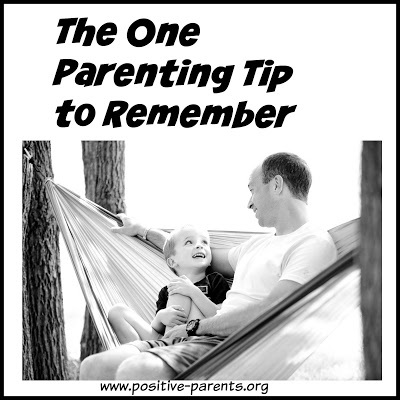
As someone who has written three books and numerous articles on the subject of parenting, I know that I (and many other parenting book authors and bloggers) write with the intention of inspiring, encouraging, and empowering parents. Yet I also know that the Internet and bookstores are filled with conflicting advice and opinions on child rearing, and sometimes what is intended to be empowering actually feels condemning. What is meant to be encouraging may be discouraging. What is written to be inspiring ultimately may leave you feeling confused, anxious, guilty, or just plain angry. It’s so hard to know which voices to listen to in a sea filled with endless voices.
The best piece of advice I can give to my readers is the advice I had to learn to take myself: in the end, the voice you need to listen to is your own. Not the reactive, knee-jerk voice or the critical voice you carried with you from childhood, but the quiet, calm inner stirring that you’re sometimes afraid to listen to because it’s starkly different from all the other voices surrounding you. That quiet, calm, peaceful inner voice whispers love and connection because that is what we are designed for.
Parenting is a long, tough game, and whether you’re at the top of the first or the bottom of the ninth, you’re playing your heart out because you know it’s all on the line. You want to make all the right choices, so you read countless pages and weigh the science and consult your trusted friends, and you do the best you can. Then, you read something that goes directly against the decision you just agonizingly made and you start questioning yourself all over again. It’s exhausting, I know, to have a constant stream of “you should do this” and “you’d better not do that” messages thrown at you every day.
The further along I get in this game, the more I’m convinced that there is no right way to play for every team but that there is a best way for each individual, unique team. We can all have different playbooks and still play really well, but there is one single quality every team must have to succeed – unity.
So, when all the messages overwhelm you and you don’t know which way to turn, remember this one parenting tip: Unity is first and foremost. Always. Your relationship with your child is number one, and if the relationship isn’t right, nothing else will fall into place smoothly. When you’re not attached at the heart , you lose true authority, and parenting becomes exponentially more difficult. Any time you find yourself struggling in parenting, ask yourself if you’re connected with your child . Are you unified?
In times such as these, I can’t think of anything more important than keeping our children close. Through connection, you will have influence on their values and character. If, instead, they give their hearts to their peers because the attachment with you isn’t strong enough, then it is their peers who will have the influence to shape them. Connection with you will give them confidence, resilience, and a soft place to land when the world knocks them down.
Inevitably, there will be times of conflict between parent and child. We are not on peer level with them, and we cannot always make them happy, but we can always be the one to extend the invitation for closeness, to repair when conflict occurs , and to keep our finger on the pulse of the relationship. Without this important foundation, all else we try to build is in risk of falling. But with that strong foundational support, we can truly build something beautiful and everlasting.
 Rebecca Eanes, is the founder of positive-parents.org and creator of Positive Parenting: Toddlers and Beyond. She is the author of 3 books. Her newest book, Positive Parenting: An Essential Guide, was released on June 7, 2016. The Newbie's Guide to Positive Parenting and a co-authored book, Positive Parenting in Action: The How-To Guide to Putting Positive Parenting Principles in Action in Early Childhood are both best-sellers in their categories on Amazon. She is the grateful mother to 2 boys.
Rebecca Eanes, is the founder of positive-parents.org and creator of Positive Parenting: Toddlers and Beyond. She is the author of 3 books. Her newest book, Positive Parenting: An Essential Guide, was released on June 7, 2016. The Newbie's Guide to Positive Parenting and a co-authored book, Positive Parenting in Action: The How-To Guide to Putting Positive Parenting Principles in Action in Early Childhood are both best-sellers in their categories on Amazon. She is the grateful mother to 2 boys. **This post was originally published at Creative Child Magazine

Published on January 04, 2017 08:27
October 31, 2016
Kids' Birthday and Christmas Gift Guide
Christmas is only weeks away! And if you're like me, you have birthdays coming up just before Christmas!
Finding the appropriate gift can be time-consuming, and a bit stressful- whether it's coming directly from you or from your child to their pal. I created a gift guide so you can focus on enjoying time with loved ones (and getting on with your day!) rather than hemming and hawing at all of the options. The gifts are organized by age group from toddler to teen, and all of them are under $40. Happy gifting!
For giftees ages 3 to 5 Geometric Building Set Tegu Blocks combine fun colors, geometric shapes, and a magnetic snap to create a playtime experience that's fitting for the living room or the classroom. Parents (and littles!) love this toy because its production has positive environmental and social impact.
Tegu Blocks combine fun colors, geometric shapes, and a magnetic snap to create a playtime experience that's fitting for the living room or the classroom. Parents (and littles!) love this toy because its production has positive environmental and social impact.

Make a Match Game This game helps children grow memory skills with adorable dinosaur chips! The beautiful design is a treat for parents and kids alike. Perfect for picnics, play dates, and rainy games, this game is small enough to carry in your pocket and hip enough for the coolest of pre-k birthday parties.
This game helps children grow memory skills with adorable dinosaur chips! The beautiful design is a treat for parents and kids alike. Perfect for picnics, play dates, and rainy games, this game is small enough to carry in your pocket and hip enough for the coolest of pre-k birthday parties.

For giftees ages 6 to 8 Animal Charades Game Get kids on their feet and brimming with ideas! This high-quality wooden game is a perfect gift for outgoing children and to create an atmosphere of fun and creativity.
Get kids on their feet and brimming with ideas! This high-quality wooden game is a perfect gift for outgoing children and to create an atmosphere of fun and creativity.

Pirate Adventure Board Game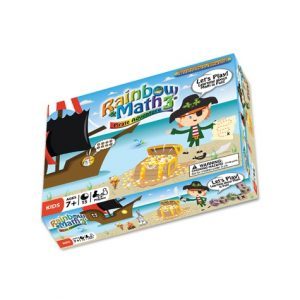 This board game is cleverly disguised. Kids will be having so much fun that they won't even know that they were learning math from an award-winning program.
This board game is cleverly disguised. Kids will be having so much fun that they won't even know that they were learning math from an award-winning program.

Squishy Science Experiment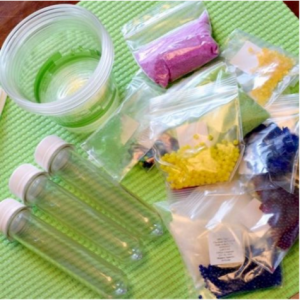 The Slimy Squishy Polymer Bucket is the perfect gift for budding scientists who aren't afraid to roll up their sleeves and get their hands dirty in the name of...scientific learning! But they'll too be busy having fun to realize they're learning the basics of chemistry.
The Slimy Squishy Polymer Bucket is the perfect gift for budding scientists who aren't afraid to roll up their sleeves and get their hands dirty in the name of...scientific learning! But they'll too be busy having fun to realize they're learning the basics of chemistry.

Garden Flowers Coloring Book One great idea for a gift is coloring books. These garden flower coloring books are perfect for child and parent, and can make a great group activity.
One great idea for a gift is coloring books. These garden flower coloring books are perfect for child and parent, and can make a great group activity.

For giftees 9 to 10 Food Fighter 2-Player Game Food Fighter is a board game that has two children face off in a kitchen-themed battle. Children will have fun while developing higher-order thinking skills, mathematics, literacy, and executive functioning skills.
Food Fighter is a board game that has two children face off in a kitchen-themed battle. Children will have fun while developing higher-order thinking skills, mathematics, literacy, and executive functioning skills.

Dream Catcher Kit Building dreamcatchers is a classic crafting activity - this colorful kit has everything kids need to make something unique and beautiful!
Building dreamcatchers is a classic crafting activity - this colorful kit has everything kids need to make something unique and beautiful!

Just Add Milk Experiments I love these experiments - little parental oversight is required, and they're so easy to do right at home! Girls and boys, readers and scientists, alike will love this colorful kit. Not to mention parents!
I love these experiments - little parental oversight is required, and they're so easy to do right at home! Girls and boys, readers and scientists, alike will love this colorful kit. Not to mention parents!

Gifts for Ages 11 to 13 Pairs in Pears Whether or not they love this pun as much as some of us, this game gets kids flexing vocabulary muscles while having fun with a little challenge and competition. Players build pairs of connecting words in matching patterns, like Scrabble 2.0. Best of all it's portable - a perfect gift and activity to bring along on sleepovers or for parties. For a little more "pearity," pair with two more pears!
Whether or not they love this pun as much as some of us, this game gets kids flexing vocabulary muscles while having fun with a little challenge and competition. Players build pairs of connecting words in matching patterns, like Scrabble 2.0. Best of all it's portable - a perfect gift and activity to bring along on sleepovers or for parties. For a little more "pearity," pair with two more pears!
 Rainforest Biome
Rainforest Biome
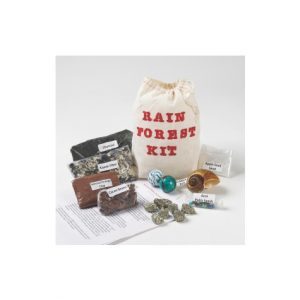 Budding scientists and tweens who like hands-on fun will love this all-in-one Rainforest Biome - they get to start a whole ecosystem right at home! The biome includes cacao beans (a favorite), clay, an apple snail shell, and more to create a full-on biofeedback loop. Super cool!
Budding scientists and tweens who like hands-on fun will love this all-in-one Rainforest Biome - they get to start a whole ecosystem right at home! The biome includes cacao beans (a favorite), clay, an apple snail shell, and more to create a full-on biofeedback loop. Super cool!

Math & Science Mystery Books Who doesn't love to solve a mystery?! The One Minute Mystery series takes a simple concept and turns it into an awesome book. Kids will read mysteries, then use their powers of deduction and knowledge of math and science to find the solution. Each is as satisfying as the next!
Who doesn't love to solve a mystery?! The One Minute Mystery series takes a simple concept and turns it into an awesome book. Kids will read mysteries, then use their powers of deduction and knowledge of math and science to find the solution. Each is as satisfying as the next!

*This post contains affiliate links.
Finding the appropriate gift can be time-consuming, and a bit stressful- whether it's coming directly from you or from your child to their pal. I created a gift guide so you can focus on enjoying time with loved ones (and getting on with your day!) rather than hemming and hawing at all of the options. The gifts are organized by age group from toddler to teen, and all of them are under $40. Happy gifting!
For giftees ages 3 to 5 Geometric Building Set
 Tegu Blocks combine fun colors, geometric shapes, and a magnetic snap to create a playtime experience that's fitting for the living room or the classroom. Parents (and littles!) love this toy because its production has positive environmental and social impact.
Tegu Blocks combine fun colors, geometric shapes, and a magnetic snap to create a playtime experience that's fitting for the living room or the classroom. Parents (and littles!) love this toy because its production has positive environmental and social impact.

Make a Match Game
 This game helps children grow memory skills with adorable dinosaur chips! The beautiful design is a treat for parents and kids alike. Perfect for picnics, play dates, and rainy games, this game is small enough to carry in your pocket and hip enough for the coolest of pre-k birthday parties.
This game helps children grow memory skills with adorable dinosaur chips! The beautiful design is a treat for parents and kids alike. Perfect for picnics, play dates, and rainy games, this game is small enough to carry in your pocket and hip enough for the coolest of pre-k birthday parties.

For giftees ages 6 to 8 Animal Charades Game
 Get kids on their feet and brimming with ideas! This high-quality wooden game is a perfect gift for outgoing children and to create an atmosphere of fun and creativity.
Get kids on their feet and brimming with ideas! This high-quality wooden game is a perfect gift for outgoing children and to create an atmosphere of fun and creativity.

Pirate Adventure Board Game
 This board game is cleverly disguised. Kids will be having so much fun that they won't even know that they were learning math from an award-winning program.
This board game is cleverly disguised. Kids will be having so much fun that they won't even know that they were learning math from an award-winning program.

Squishy Science Experiment
 The Slimy Squishy Polymer Bucket is the perfect gift for budding scientists who aren't afraid to roll up their sleeves and get their hands dirty in the name of...scientific learning! But they'll too be busy having fun to realize they're learning the basics of chemistry.
The Slimy Squishy Polymer Bucket is the perfect gift for budding scientists who aren't afraid to roll up their sleeves and get their hands dirty in the name of...scientific learning! But they'll too be busy having fun to realize they're learning the basics of chemistry.

Garden Flowers Coloring Book
 One great idea for a gift is coloring books. These garden flower coloring books are perfect for child and parent, and can make a great group activity.
One great idea for a gift is coloring books. These garden flower coloring books are perfect for child and parent, and can make a great group activity.

For giftees 9 to 10 Food Fighter 2-Player Game
 Food Fighter is a board game that has two children face off in a kitchen-themed battle. Children will have fun while developing higher-order thinking skills, mathematics, literacy, and executive functioning skills.
Food Fighter is a board game that has two children face off in a kitchen-themed battle. Children will have fun while developing higher-order thinking skills, mathematics, literacy, and executive functioning skills.

Dream Catcher Kit
 Building dreamcatchers is a classic crafting activity - this colorful kit has everything kids need to make something unique and beautiful!
Building dreamcatchers is a classic crafting activity - this colorful kit has everything kids need to make something unique and beautiful!

Just Add Milk Experiments
 I love these experiments - little parental oversight is required, and they're so easy to do right at home! Girls and boys, readers and scientists, alike will love this colorful kit. Not to mention parents!
I love these experiments - little parental oversight is required, and they're so easy to do right at home! Girls and boys, readers and scientists, alike will love this colorful kit. Not to mention parents!

Gifts for Ages 11 to 13 Pairs in Pears
 Whether or not they love this pun as much as some of us, this game gets kids flexing vocabulary muscles while having fun with a little challenge and competition. Players build pairs of connecting words in matching patterns, like Scrabble 2.0. Best of all it's portable - a perfect gift and activity to bring along on sleepovers or for parties. For a little more "pearity," pair with two more pears!
Whether or not they love this pun as much as some of us, this game gets kids flexing vocabulary muscles while having fun with a little challenge and competition. Players build pairs of connecting words in matching patterns, like Scrabble 2.0. Best of all it's portable - a perfect gift and activity to bring along on sleepovers or for parties. For a little more "pearity," pair with two more pears!
 Rainforest Biome
Rainforest Biome
 Budding scientists and tweens who like hands-on fun will love this all-in-one Rainforest Biome - they get to start a whole ecosystem right at home! The biome includes cacao beans (a favorite), clay, an apple snail shell, and more to create a full-on biofeedback loop. Super cool!
Budding scientists and tweens who like hands-on fun will love this all-in-one Rainforest Biome - they get to start a whole ecosystem right at home! The biome includes cacao beans (a favorite), clay, an apple snail shell, and more to create a full-on biofeedback loop. Super cool!

Math & Science Mystery Books
 Who doesn't love to solve a mystery?! The One Minute Mystery series takes a simple concept and turns it into an awesome book. Kids will read mysteries, then use their powers of deduction and knowledge of math and science to find the solution. Each is as satisfying as the next!
Who doesn't love to solve a mystery?! The One Minute Mystery series takes a simple concept and turns it into an awesome book. Kids will read mysteries, then use their powers of deduction and knowledge of math and science to find the solution. Each is as satisfying as the next!

*This post contains affiliate links.
Published on October 31, 2016 06:08
October 7, 2016
Are You a Happy Mom? (Survey)
Please take a moment to participate in my survey. I'm gathering data for a new book on finding sustaining happiness in the chaos of motherhood. Thank you!
Published on October 07, 2016 06:56
15 Ways to Connect with Your Child in 5 Minutes or Less
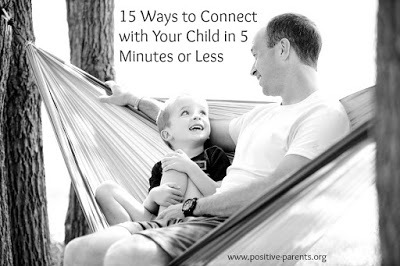
Ask any parent how things are going and you’re likely to hear some version of “we are staying busy.” Whether you think busyness is a disease resulting in families being over-stressed and not spending enough time together or you see the productivity as a good thing that is benefiting your brain , few will dispute that we are, in fact, a busy people. The good news is that it appears that quality time with our kids trumps quantity . While I’ll always advocate for slowing down and savoring those precious miracle moments with our loved ones, I understand that some days are just so packed that there are only a few spare minutes with which to connect with our kids. For those days, here are 15 ways to connect in just five minutes or less.
1. Gather your child in your lap and read a short story. Of course, this is much easier to do with little kids who still fit on your lap, but if your child is older, sit beside him and read a chapter of Percy Jackson out loud. By making this a daily ritual, you’ll spark a love for reading and spend some quality time together every single day.
2. Offer a heart-felt hug and be the last to let go. This article by Marcus Falicetti outlines why we need at least eight hugs per day. Lots of good comes from a hug, and it doesn’t even take five minutes!
3. Give full, undivided attention to your child and start with saying, “These next five minutes are all yours.” Ask them about their day, how they’re feeling, or what they’re interested in most right now. Make eye contact and listen attentively. We do that so little these days because everybody is checking their devices or multitasking and only giving partial attention. Five minutes of full attention will go a long way in strengthening your connection.
4. Meet their strong emotion with empathy . Sometimes this is inconvenient or even downright tough, and our first reaction is often to shut it down quickly. When we can sit with our children through their big feelings, they get the message “I matter” or “I’m understood” and that fosters a deeper connection to us.
5. Play a game of Tic Tac Toe, Hangman, or have a drawing contest. Keep a small notepad in your vehicle or purse for on-the-go fun. Make use of the time you’re waiting in line at the grocery store or at the doctor’s office by playing one of these games together and you just might feel less exasperated by your wait and more connected with your child.
6. Have an impromptu dance party. Inject a little fun and spontaneity into your day by turning on a good dance song and sliding around the kitchen in your socks.
7. Tell each other jokes. Laughter equals connection.
8. Stuck in the car? Play a car game like “I Spy” or “Twenty questions.”
9. Special time before bed is a lovely way to end the day. Lie beside your child or sit at the end of the bed and just spend a few minutes talking or giving a back rub.
10. Roughhouse and wrestle around a bit. Give piggy back rides or horsey rides, swing them around, and chase them.
11. Visit their world . Get involved in something that your kid is interested in, like Minecraft for instance. Ask questions. When we show kids that we care about the things they care about, they feel connected.
12. Do a chore together and make it fun. It has to get done anyway, so you may as well use the time wisely and play while you work !
13. Become journal buddies. Whether you just use a composition notebook or buy a journal like Journal Buddies: A Boy’s Journal for Discovering and Sharing Excellence or Just Between Us: Mother & Daughter: A No-Stress, No Rules Journal , writing back and forth is a great way to connect with your child.
14. Spend those 5 minutes outside playing tag, looking for bugs, or collecting leaves. Play hopscotch, blow bubbles, or jump rope. Hula hoop, toss a ball, or walk the dog. You get the idea!
15. Break out the photo albums. Looking back at old memories and cheeky baby smiles is an instant mood booster and a great way to spend quality time with your loved one.
**This article was originally published at Creative Child Magazine.
Published on October 07, 2016 05:53
A Compassionate Response to Tantrums
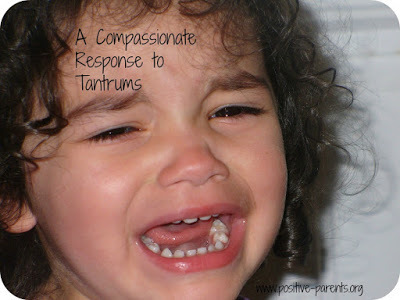
Time and again, I see and hear advice to ignore children who are in emotional distress. Those who both give and receive this advice do so with the best of intentions. They love children and believe it is in a child’s best interest to “train them out of tantrums” by ignoring because they believe that anything else will reinforce or fuel this “bad behavior.” There are several things at play here that we need to address in order to bring compassion to our responses with our children.
1. We have subscribed to the idea that tantrums are bad behavior.We believe children have tantrums in a calculative manner with the intent to manipulate us to either give them attention or give them something they want. When we understand how the developing brain of a child works, we can quickly debunk this idea that young children (babies and toddlers) are being deliberately manipulative. Rather, true tantrums occur when the limbic system (the emotional center of the brain) becomes overloaded and alarms trigger the lower brain, sending them into a meltdown. When the lower brain is in charge , children have little control over their actions, and screaming, kicking, and crying are a discharge of the overwhelming feelings.
Many things can overload the limbic system and trigger the lower brain, and to us, those things may seem very insignificant - silly even – and so our initial response is often dismissive. Who really gets that upset over the way a sandwich is cut? This judgment blocks our compassion because when we trivialize the emotional experience of another, we feel validated in not offering our support.
2. Tantrums make us uncomfortable.There’s another reason we want to ignore a tantrum and that is the emotional response it invokes in our own brains. Because we humans are so interconnected, our mirror neurons are firing when we see our child in distress and it causes us to feel like we are in distress, too. We don’t want to feel uncomfortable, so we push the cause of our discomfort (the child) away. Ignoring is basically like constructing a mental wall that doesn’t allow their pain to become our pain, and here again, trivializing their experience comes in handy because we use that “logic” (thanks to our fully developed frontal lobes) to ease our own discomfort.
3. We are afraid that compassion will reward the tantrum. Connection is one of our most basic human needs. We all long to feel heard, validated, loved, accepted, and attached, not only when we are our best selves, but also when we are our worst selves. Imagine a spouse, partner, or friend withdrawing their attention and warmth from you because you are crying, upset, and in emotional distress. What would it do for your relationship? How would it affect your emotional state? Now imagine that these people gave you a shoulder to cry on, listened as you communicated your frustration or sadness, and then, even if they couldn’t solve your problem for you, they said “I’m here for you.” Now ask yourself those same two questions.
Compassion is not a reward; it is the heart of relationships.Psychologist, science writer, and emotional intelligence expert, Daniel Goleman says, “True compassion means not only feeling another’s pain but also being moved to help relieve it.” To extend compassion, we have to be willing to allow ourselves to feel our own discomfort and yet have the emotional stability to not become entangled in their distress but to be the lighthouse that shows them the way through the storm.
Different Kinds of Tantrums:Thus far, I’ve been talking about the true emotional overwhelm, or what Tina Payne-Bryson calls “downstairs tantrums.” Read Upstairs and Downstairs Tantrums for a complete explanation. Sometimes, particularly in older children beyond the preschooler years, a child will “pitch a fit” in an attempt to get you to give in. Hey, the frontal lobe is maturing! This isn’t true emotional distress, and parents can tell the difference. Even during this type of tantrum, though, you can still show compassion while standing your ground. When he realizes the fit doesn’t get him what he wants, it won’t be a tool he uses, and when you stay compassionate and calm in the face of it, he’ll learn what it looks like to show maturity.
The Bottom Line:We don’t have to make a new sandwich and cut it the right way, buy them the toy, or let them stay up an hour later nor do we have to send them to their room or ignore them completely. Neither approach is the best for fostering emotional health. Instead, I believe in offering compassionate, loving support while holding our boundaries and then, once the storm has passed, actively teaching children about their emotions and how they can respond when they feel upset. This approach strengthens relationships, resilience, and emotional intelligence.
Children must learn that kicking and screaming on the floor is not the way to deal with upsets, but they don’t learn how to handle those emotions by kicking and screaming alone. They learn by watching how we handle our upsets and by what we teach them before and after an emotional meltdown.
So don’t ignore! Help.
Further Reading:
Tackling Distress Tantrums with Brain Research
Tantrums: Moving Beyond the Black and White of Ignoring or Giving In
Why Your Child Can’t Think Straight During a Tantrum
**This post was originally published at Creative Child Magazine.

Published on October 07, 2016 05:33
September 16, 2016
The Lessons My Children Taught Me
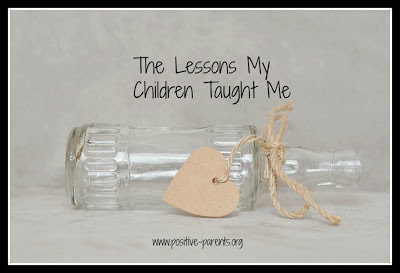
I’ve taught my children many, many things in my decade of parenting, but the lessons they’ve taught me are far greater and more valuable than I ever expected. In a bizarre twist, it turns out that my children have, indeed, been my greatest teachers in life. I knew it was my honor to raise them, but what I didn’t know was just how much they’d raise me (or at least inspire me to rise).
Lesson One: How to Love Unconditionally
I suppose, like them, I was born knowing how to do this, but somewhere along the way, I learned to love with conditions, or more specifically, to show love with conditions. For me, it took having a child to see what real, unconditional love looks like, and that’s the kind of love I’m now striving to give back to them. The pure love they give to me is not based on my performance as a mother, but on the simple, sweet fact that I am their mother. That’s the love I want to return – a love not based on actions, accomplishments, or attitudes, but given purely because of who they are.
Lesson Two: Grudges are Ridiculous
I’ve been known to hold a grudge. There have been some things that people have done to me that have just been hard for me to let go of. It’s hard to see past the hurt. Not for children, though. My kids can be in an argument at 10 am and by 10:04, the whole thing is forgiven and forgotten. I see the freedom in letting go through watching my children, and I’m working toward being more like them.
Lesson Three: The World is Full of Wonder
This is another one of those beautiful lessons long forgotten until I had children. The amazement of a butterfly fluttering about, the joy of blowing bubbles and watching them being carried away by the wind, the beauty of clouds and their many fascinating shapes – the world is a wonderful place with so much to discover, even in our own backyards. Seeing once more through the eyes of a child is one of the greatest gifts of parenthood.
Lesson Four: Slower is Better
Our adult schedules can get ridiculously hectic. Even when our physical responsibilities are done, our minds rarely stop racing. It often seems to me like the world is whirring by my head and I just can’t keep up, but my children have taught me the value of slowing down. Not only do children live at a slower pace, taking their sweet time to get out the door when we needed to be somewhere 5 minutes ago, but just the fact that I see them growing so quickly has made me purposefully slow down and be present. Plus, when you’re blasting off into outer space on a super important mission with a 7-year-old, tomorrow’s to-do list just has to wait.
Lesson Five: There is Always Joy
Every day brings something to be excited about if we choose to look for the joy. My sons see joy in the rain puddles where my adult eyes see the forthcoming pile of wet laundry. They usually see joy where I see messes, so I’m learning to look for the joy in the messes, too. It’s often found in the piles of Lego bricks or the splattering of paint on the kitchen table that missed the paper. It’s found in riding a scooter into the wind or petting the soft fur of an orange kitten. Most recently for me, it was found in waking up on a summer morning with two long, gangly kids in my bed, one asleep with his arm thrown over his brother, and the gratitude washed over me like a warm wave because I realized that this – every single day I get to spend with them, my greatest teachers – is joy.
**Originally published at Creative Child

Published on September 16, 2016 05:46



